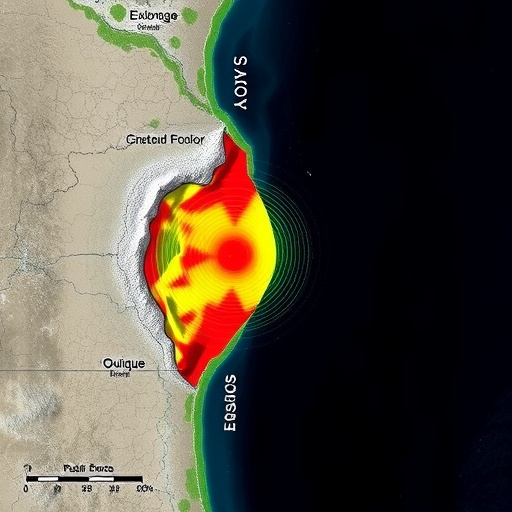In the relentless quest to decipher Earth’s seismic mysteries, an international team of researchers has made a groundbreaking discovery that reshapes our understanding of aftershock phenomena following massive earthquakes. Their new study reveals that pore-pressure diffusion—a process involving the movement of fluids within the Earth’s crust—plays a controlling role in governing the aftershock sequence in the upper plate following the 2014 Iquique earthquake. This insight not only deepens our grasp of earthquake dynamics but also opens avenues for improving seismic hazard assessments in subduction zones worldwide.
The 2014 Iquique earthquake, which struck the northern coast of Chile with a magnitude of 8.1, was a significant event in recent seismological history. This megathrust earthquake occurred along the convergent boundary where the Nazca Plate subducts beneath the South American Plate. While the main shock captivated scientists and the public alike, the aftermath—the aftershock sequence—has remained a subject of intense scrutiny. Aftershocks do not just dissipate randomly; rather, they unfold in a complex spatial and temporal pattern that hints at the intricate processes operating beneath the surface.
In their study, the researchers have focused on the role of pore-pressure diffusion in controlling the aftershocks within the upper plate—that part of the crust above the fault interface where the initial rupture occurs. Pore pressure refers to the pressure of fluids—such as water or supercritical fluids—that occupy the tiny pores and fractures within rock formations. The diffusion of these fluids from regions of higher pressure to lower pressure can significantly influence the stress state in the crust, potentially triggering or inhibiting seismic events.
To unravel this complex phenomenon, the team employed advanced numerical simulations combined with detailed geophysical data collected from the region. Their model integrates the hydraulic and mechanical properties of the crustal materials, capturing how pore fluids migrate through fractured rock over time following the main earthquake. By doing so, they simulated the diffusion of pore pressure and its effect on stress changes along faults in the upper plate, providing a mechanistic explanation for the distribution and timing of aftershocks observed after the Iquique quake.
Remarkably, their findings demonstrate that pore-pressure diffusion acts as a crucial driver that governs the nucleation of aftershocks in the upper plate. As fluids propagate through the crust, the consequent increase in pore pressure reduces the effective normal stress on faults, effectively “lubricating” them and making them more susceptible to failure. This process can extend the duration of aftershock activity well beyond the immediate aftermath of the main shock and influence the spatial pattern of seismicity away from the fault interface.
Furthermore, the study highlights how pore-pressure diffusion can cause aftershocks to cluster in previously unanticipated zones within the upper plate. This challenges conventional models that primarily attribute aftershock occurrence to static stress changes resulting from the earthquake’s rupture. Instead, the dynamic redistribution of fluid pressures emerges as an equally critical factor, imposing temporal delays and spatial heterogeneities on aftershock sequences.
The implications of these discoveries are profound for seismic hazard modeling. Traditional earthquake forecasts often rely on mechanical stress transfer models that do not consider fluid effects explicitly. Incorporating pore-pressure diffusion mechanisms could significantly refine aftershock predictions, thereby enhancing preparedness and risk mitigation strategies in vulnerable subduction regions. Given that megathrust earthquakes occur frequently along convergent margins worldwide, these findings bear global relevance.
This research also bridges the gap between seismology and hydrogeology, illustrating the essential interplay between geological fluids and tectonic processes. It underscores the importance of measuring and monitoring pore-fluid pressures in fault zones, a challenging yet vital task. Such observational data could validate and calibrate numerical models, enabling more accurate forecasts of fault behavior under variable fluid conditions.
From a methodological standpoint, the study showcases the power of integrating multidisciplinary approaches, including geomechanics, fluid dynamics, and high-resolution seismic observations. By fusing these perspectives, the researchers have forged new pathways to decipher the subterranean mechanics of earthquake aftershocks—mechanisms that have long eluded comprehensive understanding.
Moreover, this work prompts a reconsideration of the temporal scales involved in aftershock sequences. Conventional wisdom tends to confine aftershock activity to weeks or months post-main event; however, the slow diffusion of fluids indicates that elevated pore pressures may sustain seismic hazard over years or even decades. This long-term perspective is crucial for communities residing near active fault zones.
The study also offers a valuable lens through which to interpret anomalous aftershock patterns observed in other subduction earthquakes around the world. By applying their model to diverse tectonic settings, researchers may uncover universal principles governing aftershock dynamics or identify region-specific variations shaped by local geology and fluid properties.
Perhaps most intriguingly, the findings invite further exploration into human-induced seismicity, where fluid injection or extraction alters pore pressures artificially. Understanding natural pore-pressure diffusion processes can inform safer practices in geothermal energy, hydraulic fracturing, and carbon sequestration projects, reducing the risk of triggering unintended earthquakes.
In conclusion, this groundbreaking investigation into the pore-pressure diffusion controlling upper-plate aftershocks of the 2014 Iquique earthquake marks a significant leap forward in earthquake science. It reveals the hidden influence of subterranean fluids on fault stability and aftershock evolution. As geoscientists worldwide assimilate these insights, new horizons open for more accurate seismic risk assessment, fostering resilient societies in the face of Earth’s dynamic and often unpredictable behavior.
Subject of Research: Pore-pressure diffusion and its influence on upper-plate aftershocks following the 2014 Iquique megathrust earthquake.
Article Title: Pore-pressure diffusion controls upper-plate aftershocks of the 2014 Iquique earthquake.
Article References:
Peña, C., Heidbach, O., Metzger, S. et al. Pore-pressure diffusion controls upper-plate aftershocks of the 2014 Iquique earthquake. Nat Commun 16, 9474 (2025). https://doi.org/10.1038/s41467-025-65013-6
Image Credits: AI Generated




